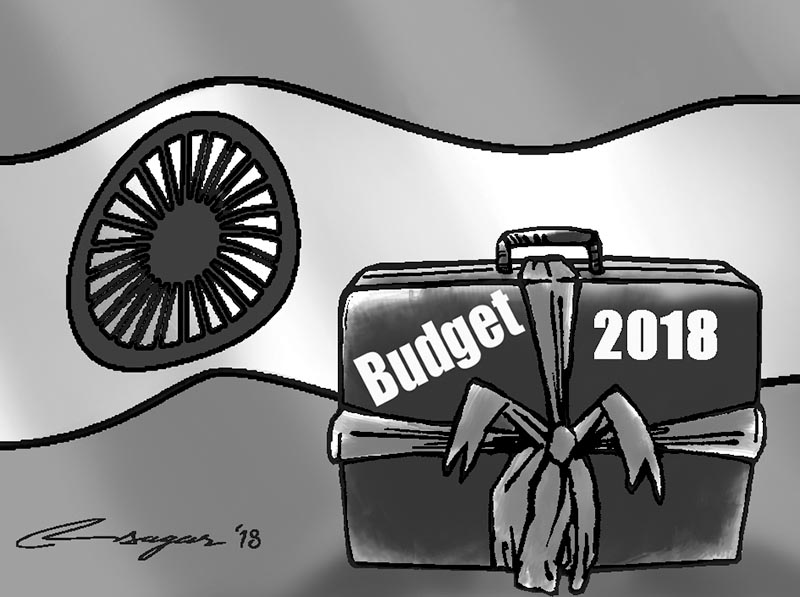Budget in India: Some takeaway lessons for Nepal
The Narendra Modi-led government in India presented its fifth and last union budget on February 1. What are the major takeaways for Nepal from the budget of the world’s largest democracy?
The government of India presented its Union Budget 2018 on February 1. The budget presented in the Indian parliament can be a good resource for policy makers in Nepal. This is the fifth and last full budget by the Narendra Modi-led government as India will go to general elections next year. In Nepal also, a new government is set to take shape, which is expected to serve a full five-year term.
What are the major takeaways for Nepal from the budget of the world’s largest democracy? Can policy makers in Nepal adopt some of the approaches taken by the Indian government in its budget?
The Indian budget, presented by Finance Minister Arun Jaitley, attempts to woo the rural population, which accounts for more than 50 per cent of total voters. Through notable focus on investment in agricultural and rural development, the Indian government has expressed a strong desire to bolster the rural economy. This follows the realisation that the deepening agrarian distress was having an impact on the overall economy. Nepal also shares similar socio-economic background where more than 60 per cent population is engaged in the disconsolate agrarian sector.
Let’s look at some other relevant areas of the Indian budget, which could be helpful for Nepali policy makers.
The “paradigm shift” approach of increasing the Minimum Support Price (MSP) for farmers by 1.5 times is one of the key components. The budget has proposed creating an institutional mechanism to ensure price support and conduct demand-driven forecast for farmers’ products. Despite the tied fiscal space, there is an increase in the facilitation of credit to farmers by 10 per cent (INR 11 trillion) over 2017-18. Further, the fulfilment of the demand of farmers to provide support price 50 percent over the cost during the winter season is a significant observation of the budget.
Launching of National Bamboo Mission and Operation Green to address production and price fluctuations in onion, potatoes and tomatoes can be yet another major takeaway for Nepal. This kind of notable attention given by the Indian government despite knowing that the agriculture comprises approximately 15 percent of nation’s GDP is noteworthy. This shows that India, as one of the top emerging economies, considers agriculture still a major sector. When it comes to Nepal, the contribution of agriculture to the GDP is around 30 per cent.
Another important lesson for Nepal could be India’s health insurance scheme, which is aimed at providing INR 5 lakh healthcare cover for 10 crore families. This is touted as the world’s biggest healthcare programme. Learning from this, Nepal government can also start framing its policies to improve the healthcare system for the benefit of citizens. The recent incidents of death in Jajarkot and along the plains seem to possess major challenges to poor families, especially in case where the head of the household dies. This threatens the livelihood of the rest of the members of the family.
The budget also aims to create numerous livelihood opportunities to rural people in India, for which the government has allocated INR 14.34 trillion — both for agricultural and non-agricultural activities. This gives an impression that the country wants to deviate from jobless growth and move towards a more inclusive growth led by an increase in domestic demand. Creating jobs in the economy is the primary objective in order to uplift the economic scenario which is lacking in Nepal’s case. The future government in Nepal needs to take cognizance of the fact that growth without jobs is detrimental to the economy in the long run.
Also, a greater number of MSME (Micro, Small and Medium Scale Enterprises) after the twin macroeconomic shocks — demonetisation and GST (Good Sales Tax) — has been a great achievement for the Indian government. It certainly takes them closer towards the digitalisation, and hence helps in effective monitoring and tax collection. In order to uplift the production activities in the economy, the corporate tax rate is reduced to 25 per cent for the MSME with an annual turnover of up to INR 250 crore. It is expected that this move will benefit the micro, small and medium enterprises which are driving force for employment generation in the economy. Contrastingly, small-scale industries (such as cottage industries) in Nepal are in miserable condition.
Last but not least, with the mammoth task of boosting the growth in Indian economy, especially in the rural sector, the government of India has tried to balance the fiscal prudence with populism. Even though the government breaches the fiscal deficit target set in 2017-18 by 0.3 per cent, it has realised the urgent need of government investment to attain sustainable economic growth. So the future government in Nepal should not worry much about the fiscal prudence while drafting the policies for governmental investment in rural and agrarian sectors. The negative effect of breaching the fiscal prudence in short term will be compensated by the higher long-term return on these sectors.
It will be interesting to see whether policy makers in Nepal try to learn a lesson or two from the budget of its neighbour.
Sharma is a consultant at the National Institute for Public Finance and Policy, Ministry of Finance, GOI, New Delhi






